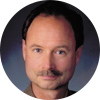| Dr. Menke leads a postgraduate course on "Integrative Chiropractic" at the National University of Health Sciences in Chicago, and is a consultant for the University of California Osher Center for Integrative Medicine, and the University of Arizona School of Medicine's integrative medicine program.
|
The University of Arizona's 1,000-hour associate fellowship program (AFP) in integrative medicine was developed to accommodate busy medical practitioners. Dr Andrew Weil founded the integrative medicine program in 1994 to expose MDs to unconventional medicines and therapies. There are two major divisions of the program: the residential fellowship, which requires a two-year residency in Tucson, and the AFP, accessible only by computer.
The AFP medical Fellows, who number from 40 to 50 each year, meet in Tucson at the beginning of the first year, after the first year, and at the end of the second year. This builds community and rapport among the medical Fellows and the program faculty. Course content includes nutrition; herbs; traditional Chinese medicine; energy medicine; and the manual medicine module (osteopathy and osteopathic manipulation; chiropractic and massage). MDs learn about the history and philosophy of each profession, its utilization, and its contribution to patient care.
I developed the chiropractic module with review from chiropractic leaders, and chose supplementary readings for the associate Fellows. We start with a short history of the chiropractic profession; address specific issues of interest and concern to medical physicians: straights versus mixers; subluxation; research on chiropractic practice; and its safety, efficacy and effectiveness. My intent was to emphasize the current and potential role of chiropractic practices in contemporary health care in an integrated environment.
The purpose of the AFP is to open medical eyes to the possibilities and resources available in unconventional (nonmedical) healing systems. The MD may want training in an "unconventional" therapy, such as Chinese or Ayurvedic medicine (try explaining to the Chinese that acupuncture is unconventional), but would (or should) receive in-depth training and certification. For such healing arts, a training approach in the AFP is to "discuss and refer." The idea is for MDs to learn more about nonmedical therapies. If MDs get a better understanding of what chiropractors do, for instance, they will be more comfortable and empowered to contact chiropractors to refer patients for treatment and case management.
The chiropractic curriculum was designed to emphasize its strengths for improved health care outcomes. That is, chiropractic was presented in an application context (based on evidence), as opposed to a historical-philosophical context. Can chiropractic management of musculoskeletal pain save health care dollars and improve health outcomes? At the patient level, an integrative chiropractor (not an anti-medicine chiropractor) can receive referrals and report back with a working diagnosis and treatment plan. After a prescribed trial of care, the chiropractor will decide if the healing response is sufficient to bring about full resolution with continued care; if not, referral is made to the next best provider, or back to the referring doctor. Benchmarks for care and improvement must be compatible, or at least explainable in standard health care terms. For example, pain, disability and dysfunction are terms familiar to chiropractors treating within the workers' compensation system and to physical medicine in general.
Following on the work of Brian Berman,1,2 Boucher,3 Crock4 and others, all the AFP manual medicine modules have an online premodule survey of attitudes toward chiropractic followed by a post-course survey to measure change in attitudes, beliefs and knowledge as a result of taking the course. The manual medicine web team also felt this would provide an important program evaluation component to point to areas of improvement. Initial results of the survey sounded grim: "Dr. Menke, most MDs responding to the survey are not very positive about chiropractic." The fundamental question, however, was: Could the value of chiropractic be conveyed through 40 hours of content and interaction in an online learning module?
The online learning site opened in May 2002. Over the next two months, the AFP doctors logged on from around the U.S. and abroad. They read the online content, the companion booklet and research references. They discussed various questions, and were given the assignment of visiting a chiropractor for treatment/adjustment. They then reported back to the group their experiences in a structured, qualitative data format. I monitored the site and moderated the interprofessional discussions. In the process we have garnered valuable data on medical attitudes toward chiropractic. We seek to correct misperceptions and generally open the "space" for greater cooperation and improved health for all patients.
To date, 100 percent of the AFP physicians who have taken the course state they will refer patients to chiropractors.
References
- Berman BM, Singh BK, Lao L, Singh BB, Ferentz KS, Hartnoll SM. Physicians' attitudes toward complementary or alternative medicine: a regional survey. J Am Board Fam Practitioner 1995;8:361-366.
- Berman BM, Singh BB, Hartnoll SM, Singh BK, Reilly D. Primary care physicians and complementary-alternative medicine: training, attitudes, and practice patterns. J Am Board Fam Practitioner, Jul/Aug 1998;11(4):272-281.
- Boucher TA, Lenz SK. An organizational survey of physicians' attitudes about and practice of complementary and alternative medicine. Alternative Therapies, Nov 1998;4(6):59-65.
- Crock RD, Jarjoura D, Polen A, Rutecki GW. Confronting the communication gap between conventional and alternative medicine: a survey of physicians' attitudes. Alternative Therapies, March 1999;5(2):61-66.
J. Michael Menke,MA,DC
Palo Alto, California
Click here for previous articles by J. Michael Menke, MA, DC, PhD.





